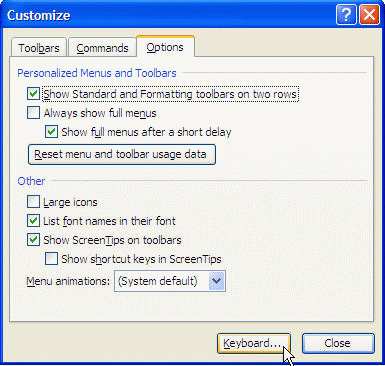Customizing Microsoft Word Keyboard Shortcut keys is easy.You can create customized keyboard shortcuts in anydocument, or anytemplate.
When you create a shortcut, you must make sure you’re putting it in the right place:
If you want your shortcuts to be available whenever you’re using Word, create them in Normal.dot. Normal.dot is a global template loaded all the time when Word is running.If you need a shortcut only in documents based on a particular template, create it in that template.If you need a shortcut only in a particular document, create it in thatdocument.
To Create a new Microsoft Word Keyboard Shortcut
From the Tool menu, click on the Customize button.From the Customize dialog box displayed, click on the Keyboard button to display the Customize Keyboard dialog box. The Customize Keyboard dialog box lets you assign a keyboard shortcut to almost any command, macro, font, AutoText entry, style, or common symbol.
The Customize Keyboard dialog box lets you assign a keyboard shortcut to almost any command, macro, font, AutoText entry, style, or common symbol.

| In the Categories: list box, select the category of item for which you want to create or change the keyboard shortcut. The list box to the right of the Categories: list box changes its name to match the category you select. - Each of the eight menu categories (File, Edit, View, Insert, Format, Tools, Table, and Window and Help) lists the commands associated with that menu. The more commonly used commands appear on the menus, while the less-used commands don’t appear. For example, the FilePrint command appears on the File menu as the Print command, but the FileConfirmConversions command doesn’t appear.
- The Drawing category lists the commands associated with the Drawing toolbar.
- The Borders category lists the commands associated with the border buttons on the Tables and Borders toolbar.
- The Mail Merge category lists the commands associated with the Tools > Letters and Mailings submenu (in Word 2003 and XP) and with the Mail Merge toolbar.
- The All Commands category lists all Word commands. Because there are so many commands, this list is awkward to use, so you’ll probably want to use it only when you can’t remember which menu a command is associated with.
- The Macros category lists all the macros available in the active document and templates.
- The Fonts category lists the fonts installed on Windows XP.
- The AutoText category lists the AutoText entries defined in Word.
- The Styles category lists the styles available in the active document and templates.
- The Common Symbols category lists frequently used symbols (such as dashes, ® and © marks, and paragraph marks).
In the Commands: list box, select the command for which you want to create or change a keyboard shortcut. Word displays any existing keyboard shortcut for the command in the Current Keys: list box.If you wish to assign the keyboard shortcut for a specific command, key in the shortcut in the Press new shortcut key: text box.
Note: If this shortcut is currently assigned to another command, Word displays the Currently Assigned To line listing the command, so that you’ll know which existing shortcut you’re about to overwrite. Choose a different keyboard shortcut if necessary.Click the Assign button to assign the keyboard shortcut to the command.Click the Close button to close the Customize Keyboard dialog box.
To Remove and Reset Microsoft Word Keyboard Shortcut
From the Tool menu, click on the Customize button.From the Customize dialog box displayed, click on the Keyboard button to display the Customize Keyboard dialog box.In the Save changes in: list box, choose which document or template you want to affect, and select the command so that Word displays the current keyboard shortcut.Select the shortcut in the Current keys list box, and then click the Remove button.To reset all keyboard shortcuts in the specified document or template to their default settings, click the Reset All button.Immediately Word will prompt a confirmation message, just click the Yes button.
Note: The Reset All button isn’t available until the document or template contains customized keyboard shortcuts. After removing or resetting Microsoft Word keyboard shortcuts, save the document or template. |





No comments:
Post a Comment